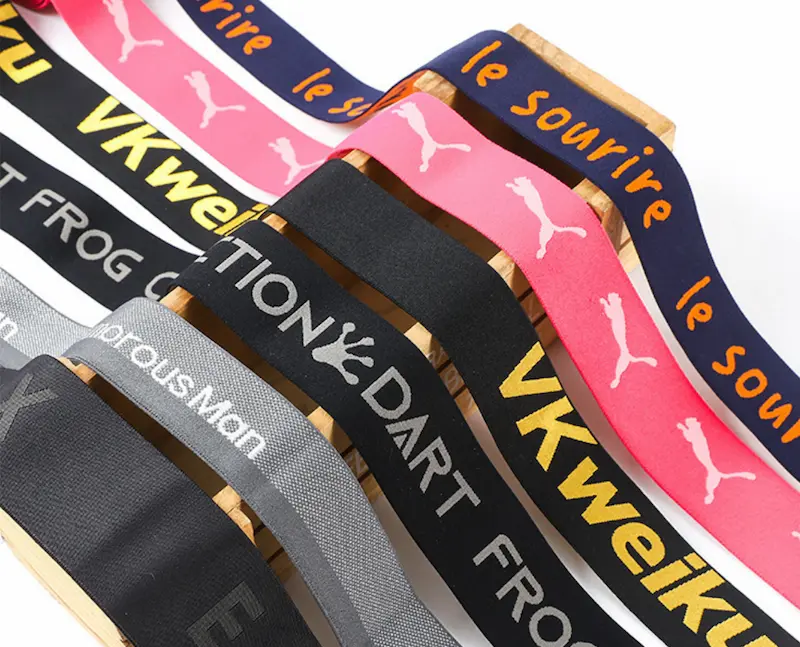For product designers in apparel, medical, and tactical industries, specifying the "wrong" elastic band is a common failure point. A waistband that rolls over, a strap that loses stretch after washing, or an edge that frays upon stitching often stems from misunderstanding the construction method (Woven vs. Knitted) or the core material (Rubber vs. Spandex).
As a custom webbing manufacturer, TMG Webbing breaks down the technical differences to help you source the correct elastic for your production line.
1. The Core Engine: Latex Rubber vs. Spandex
The "stretch" in elastic webbing comes from the elastomeric core. Your choice here defines the lifespan of the product.
- Natural Rubber (Latex):
Pros: Extremely high power and "snap-back" recovery. Lower cost.
Cons: Degrades with heat, sunlight (UV), and oils. Heavy weight. Potential allergen issues.
Best for: Industrial straps, furniture webbing, heavy-duty suspenders. - Spandex (Lycra® / Elastane):
Pros: Lightweight, excellent wash durability (shrinkage < 5%), resistant to body oils and perspiration.
Cons: Slightly higher cost than rubber.
Best for: Apparel, medical braces, underwear, and any product touching the skin.
2. Construction Methods: The Structural Difference
How the yarn is interlaced around the core determines the webbing's stability and application.
A. Woven Elastic (The Heavy Duty Choice)
Structure: Manufactured on a loom where weft and warp threads interlock tightly.
Key Feature: Transverse Integrity. Woven elastic does not narrow (neck-down) significantly when stretched. It maintains its width, making it high-tension capable.
Manufacturing Insight: Because of its tight weave, it can be stitched directly onto heavy fabrics without unraveling. It is the standard for military gear, tool belts, and footwear.
B. Knitted Elastic (The Soft Choice)
Structure: Made by knitting fibers together in a looping structure.
Key Feature: Breathability & Softness. It is thinner and softer than woven elastic but will narrow when stretched.
Manufacturing Insight: Ideally suited for "encased" applications (where the elastic is inside a fabric tunnel) like pajama waistbands, or for lightweight medical wraps.
C. Jacquard Elastic (The Branding Choice)

This is a specialized form of woven or knitted elastic where a pattern or logo is woven directly into the fabric structure using different colored yarns. Unlike printed logos which can peel off, Jacquard elastic branding is permanent and adds a premium perceive value to underwear and sportswear brands.
3. Technical Comparison Table
Use this guide to specify your requirements in your Request for Quote (RFQ).
| Feature | Woven Elastic | Knitted Elastic |
|---|---|---|
| Durability | Excellent (Heavy Duty) | Moderate (Lightweight) |
| Stretch Resistance | High Tension | Low to Medium Tension |
| Narrowing on Stretch | No (Retains Width) | Yes (Narrows) |
| Thickness | Thick, Dense | Thin, Soft |
| Needle Piercing | Unaffected by stitching | Can unravel if not secured |
4. Advanced Customization Capabilities
At TMG Webbing, we go beyond standard black and white elastic. Modern product design requires advanced treatments:
- Silicone Printing: We can apply silicone strips or dots to the back of the elastic. This is crucial for cycling shorts (leg grippers) or holster straps to prevent slipping.
- Flame Retardant (FR): Essential for racing suits and military applications.
- Variable Modulus: We can engineer the elastic to have specific elongation zones (e.g., stiff in the middle, stretchy on the edges).

Sourcing Custom Elastic?
Don't settle for generic stock. From Jacquard logo waistbands to heavy-duty woven elastic with silicone grippers, TMG creates custom solutions for your brand.
Request Elastic SamplesChoosing the right elastic is a balance of comfort, power, and cost. Contact TMG Webbing today to speak with a textile engineer about your specific project requirements.
